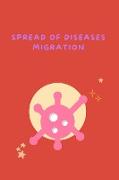- Start
- Spread of Diseases Migration
Spread of Diseases Migration
Angebote / Angebote:
Migration, the movement of people from one place to another, has played a pivotal role in shaping human history. However, with the advancement of globalization and increased interconnectedness, migration has also become a critical factor in the spread of diseases. The movement of individuals across borders and continents has facilitated the rapid transmission of infectious agents, leading to the global dissemination of diseases.Historically, diseases like the bubonic plague and smallpox spread through trade routes and conquests, leaving a trail of devastation in their wake. Today, in the age of modern transportation, the global spread of diseases is even more pronounced. Air travel, in particular, enables viruses to leap across oceans and continents within hours.The recent outbreak of infectious diseases, such as the COVID-19 pandemic, serves as a stark reminder of the interconnectedness of our world and the vulnerability of human populations to rapid disease transmission. Measures such as quarantines, travel restrictions, and international cooperation have become essential to control and manage disease outbreaks.Understanding the relationship between migration and disease transmission is crucial for designing effective public health strategies. Collaboration between nations, proactive surveillance, and robust healthcare systems are vital to mitigate the impact of diseases on a global scale.In conclusion, spreading diseases through migration is a complex and ongoing challenge that demands collective efforts and global solidarity. As we navigate an increasingly interconnected world, acknowledging this link is vital to safeguarding public health and preventing future pandemics.
Folgt in ca. 10 Arbeitstagen
